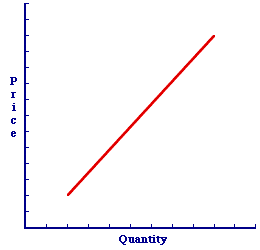
|
|
FIXED COST: In general, cost that does not change with changes in the quantity of output produced. More specifically, fixed cost is combined with the adjectives "total" and "average" to indicate the overall level of fixed cost or the per unit fixed cost. Fixed cost is incurred whether of not any output is produced. The same fixed cost is incurred at any and all output levels. This means that total fixed cost is, in fact, FIXED. However, it also means that average fixed cost, or fixed cost per unit, declines as the output level increases. Spreading out $100 over 1,000 units gives a lower per unit fixed cost that spreading out $100 over 10 units.
Visit the GLOSS*arama
|
|


|

|
                           PRODUCTION TECHNOLOGY, SUPPLY DETERMINANT: The knowledge and information that suppliers have about production (that is, production techniques or the way inputs are combined to produce outputs) which are assumed constant when a supply curve is constructed. Production technology is one of five supply determinants that shift the supply curve when they change. The other four are resource prices, other prices, sellers' expectations, and number of sellers. The information available concerning production techniques affects the ability to supply a good. Technology is what producers know about the ways to combine inputs into the production of outputs. An advance in technology makes it possible to sell more of a good. A decline in technology means producers can sell less of a good. Doing More with LessProduction technology affects the manner in which resource inputs are combined to produce outputs. An advance in technology means that a given amount of resources can be used to produce more goods, or that the same amount of production can be obtained with fewer resources.While a decline in technology is theoretically possible, advances are more prevalent and a great deal more likely. A decline in technology means that a given amount of resources can be used to produce fewer goods, or that the same amount of production can be obtained with more resources. Consider the production and supply of Wacky Willy Stuffed Amigos to illustrate an advance in technology. When William J. Wackowski founded of The Wacky Willy Company, he did so with limited technology. His sewing machines were manually operated. Workers cut patterns with simple scissors. The button eyes were attached to each stuffed creature with a needle and thread. The Stuffed Amigos were stuffed by hand. Using this limited technology, each Wacky Willy worker was able to fabricate five Stuffed Amigos per day. The Wacky Willy Company now uses more advanced production technology. The entire process is automated and computerized, from pattern cutting to sewing to stuffing. This advanced technology allows each Wacky Willy worker to produce five hundred Stuffed Amigos per day. An increase in production technology has made it possible for each Wacky Willy worker to produce more output. As a general rule, technological advances make it possible to produce more output with fewer inputs and with a reduction in production cost. Shifting the Supply Curve| Production Technology |  |
A change in production technology causes the supply curve to shift. This can be illustrated using the positively-sloped supply curve for Wacky Willy Stuffed Amigos presented in this exhibit. This supply curve captures the specific one-to-one, law of supply relation between supply price and quantity supplied. Production technology is assumed to remain constant with the construction of this supply curve.Now, consider how changes in production technology shift the supply curve. - An Advance in Technology: An advance in production technology causes an increase in supply and a rightward shift of the supply curve. With the greater technology, sellers are able to sell more Stuffed Amigos. Click the [Advance] button to demonstrate.
- A Decline in Technology: A decline in production technology causes a decrease in supply and a leftward shift of the supply curve. With the less technology, sellers are able to sell fewer Stuffed Amigos. Click the [Decline] button to demonstrate.

Recommended Citation:PRODUCTION TECHNOLOGY, SUPPLY DETERMINANT, AmosWEB Encyclonomic WEB*pedia, http://www.AmosWEB.com, AmosWEB LLC, 2000-2025. [Accessed: July 1, 2025].
Check Out These Related Terms... | | | | | | | |
Or For A Little Background... | | | | | | | | | | | |
And For Further Study... | | | | | | | | |
Search Again?
Back to the WEB*pedia
|



|

|
GRAY SKITTERY
[What's This?]
Today, you are likely to spend a great deal of time at a flea market hoping to buy either an ink cartridge for your printer or a rechargeable battery for your camera. Be on the lookout for the happiest person in the room.
Your Complete Scope
This isn't me! What am I?
|

|
|
Helping spur the U.S. industrial revolution, Thomas Edison patented nearly 1300 inventions, 300 of which came out of his Menlo Park "invention factory" during a four-year period.
|

|
|
"Experience keeps a dear school, but fools will learn in no other. " -- Benjamin Franklin
|

|
LS
Least Squares
|

|
|
Tell us what you think about AmosWEB. Like what you see? Have suggestions for improvements? Let us know. Click the User Feedback link.
User Feedback
|


|


